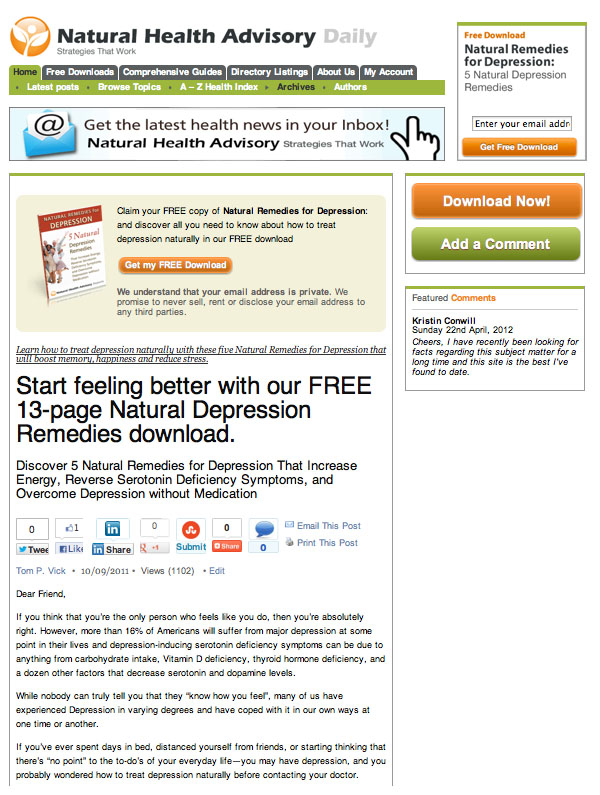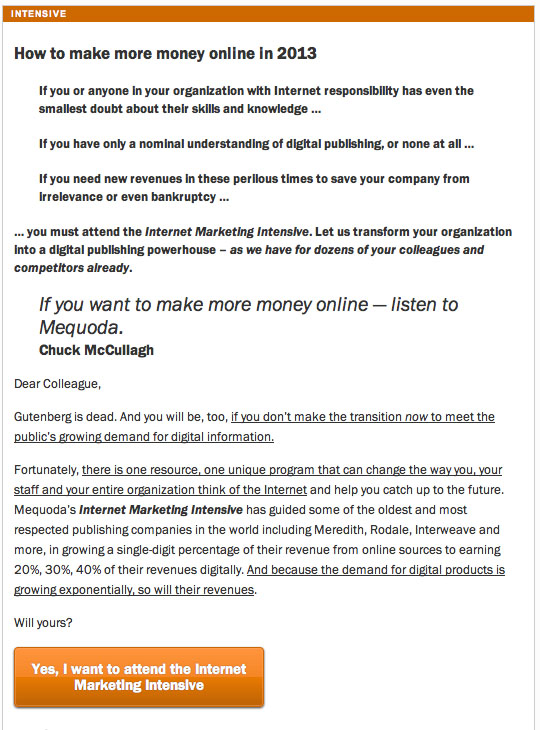Or, a thousand words are worth a single picture
Google the phrase “landing page examples” and you get 3,300,000 results. It’s enough to make the earnest copywriter throw up her hands in despair.
Of course, when you start digging into those results for actual landing page examples, you find that most of them are critiques based on the design of the page. But I’m going to completely ignore those landing page examples because it’s my blog post, and I’m a writer, not a designer. Please see posts from my colleagues Amanda MacArthur and Aimee Graeber if you want to talk design! There’s nobody here but us writers!
Why write when you can use pretty pictures?
Mequoda uses a lot of long-form, written landing pages for its clients, because of the thousands of tests we’ve done, we’ve found that a well-written long copy landing page will beat short copy four out of five times. That’s a pretty compelling statistic, and a good reason to keep your copywriter employed.
One reason for this phenomenon is that words are still better than images at conveying information that potential buyers want before they’ll make that purchase or even download a free white paper. They may not read it all, but they’ll certainly skim it for the information they want. (More on that later.)
More importantly, however: Google does not care about your pretty design. Google is all about words, and wants to see at least 300 of them in order to rank your page. Google is all-powerful. Designers, bow before it.
The first step in optimizing your page is to determine your keywords for SEO, but because my motto is, I’m a writer, you do the math, and I’m not an analytics person, I’m going to allow my colleagues Amanda and Norann Oleson to handle that for you.
I’m here to talk about what to do once you have your keywords lined up.
Organic landing page examples and landing page best practices
Great landing page examples: This one is from Natural Health, an organic landing page aimed at capturing email addresses in exchange for a free report. It was written by the aforementioned Amanda. What’s an organic landing page, you ask? It’s one that’s aimed at attracting traffic through the use of Search Engine Optimization, and Amanda’s copy here is an SEO gem. Here’s the page:

Organic landing page best practices Tip #1: Single word keywords are just too widely used to hope for any ranking for your landing page. The only pages getting decent ranking for “depression” are the Mayo Clinic, the National Institutes for Mental Health and Wikipedia. If you don’t want to compete with those guys, shoot for two- or three-word targeted phrases, or even longer ones if they’re a natural way to describe and search for your topic – in this case, four words: natural remedies for depression.
Altogether there are 22 occurrences of the phrase in the letter. Google will love ranking this page for people searching for, um, natural remedies for depression. The question is, how did Amanda do it? With living color. This image shows you the Mequoda best practice:

[text_ad]
Organic landing page best practices Tip #2: Sprinkle your keywords throughout your copy, with heaviest emphasis in the first 500 words, so that you achieve a keyword density of 3 to 5 percent for your main keywords. (At Mequoda, we usually concentrate on two or three main, or “ranking,” keywords.) SEO experts agree that over optimization will result in a negative verdict for your landing page from major search engines.
Using color coding as you write, you can start to see how well you’re doing. When you’re done writing, count a total for each keyword. And here’s how you get that important percentage:
[number of keyword occurrences] / [number of words in the document] x [number of words in keyword phrase].
In this case: 22/1813 x 4 = 4.9% KDI (Keyword Density Index). Great job, Amanda!
Organic landing page best practices Tip #3: Use other keyword phrases that are not your main, or ranking ones, to help Google further identify the subject matter of your page. Mequoda uses up to six of these keyword phrases, which we call “proximity” keywords. You want your KDI for these to be 1.5-3%. More landing page examples: On this landing page from Vibrant Nation, a page offering a free report called 5 Solutions for Painful Sex (Dyspareunia) and Vaginal Dryness in Women over 50, “vaginal dryness” is a ranking keyword with 15 occurrences, and “sex after 50” is a proximity keyword, with only eight.
Organic landing page best practices Tip #4: Use your ranking keywords in the title of articles or other content that you’re discussing on the page. That way, as Amanda did with the free report called Natural Remedies for Depression, you get to repeat it over and over naturally. And Google is looking for natural, as opposed to what it considers keyword stuffing, or mindless repetition of your keyword.
Organic landing page best practices Tip #5: Write lists of tips. Google also won’t hold it against me for writing this blog with “Landing page best practices tip” repeated over and over. This works well in blogs, which aren’t promoting something with a title that can be repeated.
Organic landing page best practices Tip #6: If you’re having trouble getting your KDI number up, go back and look for your pronouns. Often they can be switched to the keyword, again with a natural feel.
Organic landing page best practices Tip #7: Write tight! The more verbiage you type, the more keywords you have to somehow fit into that copy to keep the KDI in optimal range. I’m writing a lot here today, because I’m more interested in the instructional aspect than the SEO aspect of this blog. I won’t make 3% for my ranking keywords.
Organic landing page best practices Tip #8: Repeat your keyword phrases, more than one if you can, in subheads. Like this (have you guessed my ranking keywords yet?):
Conversion landing page examples and landing page best practices
A conversion landing page, unlike an organic landing page, is not optimized for search, and simply converts traffic into subscribers or buyers. It’s not intentionally designed to attract visitors. Obviously it’s easier and faster to write, and it’s often a letter that’s been written for outbound use in an email or direct mail, which doesn’t have to get SEO treatment.
Conversion landing page examples: Here’s one that I wrote to promote Mequoda’s Internet Marketing Intensive. It includes the agenda, speakers and past attendees, so it’s too long for SEO. It works well as a conversion letter because it follows a lot of landing page best practices, and also as an outbound letter.

Here are some landing page best practices that are derived from pure marketing copywriting, since I didn’t have to accommodate keywords in any particular way:
Conversion landing page best practices Tip #1: Start with a potent promise – in this case, How to make more money online in 2013. You can’t get much more potent than that. Greed – or the promise of more money – is one of the most powerful human emotions you can play to in your copywriting.
Conversion landing page best practices Tip #2: Write “how to” headlines (they make great email subject lines, too) because they’re proven winners. The above headline, of course, delivers this copywriting best practice too.
Conversion landing page best practices Tip #3: Back up your claim of superiority with testimonials. How could I not use Chuck McCullagh’s quote?
Conversion landing page best practices Tip #4: Open the letter itself with a powerful, punchy, straightforward statement.
Gutenberg is dead. And you will be, too, if you don’t make the transition now to meet the public’s growing demand for digital information.
Compare that to copy promoting a similar event:
In this ever-evolving world of publishing, executives from a print magazine background need to learn to adapt to the demands of the multi-platform consumer. Successful magazine brand management requires the coordination and integration of many disparate disciplines such as strategic planning, editorial, advertising, building the brand, sales and distribution, finance, international licensing and digital platforms.
Which one do you find more compelling? All those words obscure the point. As one copywriting guru says, go for clarity over creativity – but if you’re good, creativity is clarity. Tight writing gets attention and gets to the point before you lose the reader’s interest. (My journalism training is paying off at last!)
Conversion landing page best practices Tip #5: After greed, anxiety is one of the most motivating human emotions you can target in your copywriting. Introduce it early, and then promise to relieve it with your product, as the writer does in this letter for a webinar from Business Management Daily:
Keep Negativity from Infecting Your Workplace
Dealing with Troublemakers, Whiners, Pessimists and Other Difficult Employees
Just one bad apple is all it takes to infect the entire work force and demoralize everybody. Don’t let things go too far — learn how to put a strategy in place to combat negativity.
Conversion landing page best practices Tip #6: Use bullets to make it easy for readers to skim your long letter and find the information they want quickly. Here’s a good example from Johns Hopkins Health Alerts, on a page offering a free report on arthritis treatments:
Among this year’s highlights:
- Is your joint pain caused by osteoarthritis or rheumatoid arthritis? How to tell the difference.
- Are opioids the right choice for arthritis pain relief … and are they safe?
- Why experts recommend “pre-hab” before knee replacement surgery.
- The controversy over joint debridement and lavage for knee osteoarthritis. What the research suggests.
- Why doctors are excited about Xarelto for patients undergoing joint replacement surgery.
- Another reason NOT to smoke if you have rheumatoid arthritis.
There are many more tips for both organic and conversion landing pages, and there’s no way to fit them all into one blog post. Check out some of our other posts and white papers to learn more, and stay tuned to this blog on Tuesdays! If you’ve got favorite landing page examples, or other landing page best practices that you’d like to see covered, please share them!



Nice, comprehensive article, Mary…lots of good stuff to digest…thank you!
You’re very welcome, Randy! Write on!
Good tips. Thanks for putting these all together in one spot.
You’re welcome! Hope you can start using them right away to drive traffic and increase conversions!